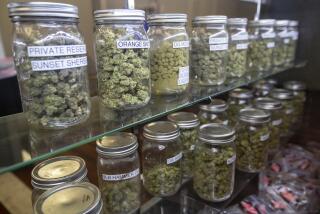Putting a lid on L.A.’s pot dispensaries
The Los Angeles City Council first welcomed medical marijuana dispensaries, then tried to regulate them, then tried to ban them. The ban has now been suspended because opponents collected enough signatures to force a ballot referendum to overturn it, leaving the council with this quandary: Should it put the referendum on the ballot and hope to persuade voters to hold fast to a ban (and then figure out a way to enforce it); or should it lift the ban now, obviate the need for the public vote and then get back to the difficult work of drafting an effective and enforceable ordinance that both improves access for the medical patients who were the intended beneficiaries of the original law and protects neighborhoods from over-proliferation of poorly regulated dispensaries?
A few years ago, before the council blundered into the dispensary mess and invited legal challenges with poorly drafted ordinances, the answer might have been different. But it’s too late for a ban in Los Angeles. Marijuana, readily available to medical patients and others, has gained too strong a foothold in this city to be banished without an investment of police and other city resources that the council and mayor have so far shown no interest in allocating and that City Hall may, frankly, simply lack. The fact that advocates gathered as many signatures as they did in such a short time is strong evidence that pro-marijuana forces have organized, gained political allies and won substantial public support. Besides, Californians have made clear their desire that marijuana be made available to medical patients.
Even if voters could be persuaded to uphold the council’s ban, the city hasn’t demonstrated much of an ability to close dispensaries. Besides, as with so many issues connected with medical marijuana, the ban is somewhat hazy. It’s a ban that’s not really a ban because it would permit certain small operations to open or to remain open. There are bound to be additional legal challenges. It would be smarter, and better policy, to go back to the drawing board and return with an ordinance to limit and regulate dispensaries -- and a plan to enforce it.
There are many marijuana advocates who argue that the city’s attempted ban was illegal and that those who brought it forward -- Councilman Jose Huizar and City Atty. Carmen Trutanich -- were mean-spirited or backward looking. That’s untrue. A ban on over-the-counter, for-profit retail sales -- and let’s please be honest enough with ourselves to acknowledge that that’s the business of the vast majority of so-called dispensaries -- has unmistakable appeal. The legal landscape of medical marijuana has shifted drastically, in many directions, over the last several years. Court rulings and enforcement patterns are bound to remain volatile for some time to come, because like it or not, marijuana remains a Schedule I drug under the federal Controlled Substances Act and is illegal in California as it is everywhere else in the country, notwithstanding the passage of Proposition 215, the Compassionate Use Act, in 1996.
The Los Angeles City Council once had a law that purported to regulate the locations and concentration of dispensaries, but it replaced that law with its now-suspended soft ban when courts overturned a parallel regulatory ordinance in Long Beach. An appeals court threw out the Long Beach law on the theory that, by saying where dispensaries could and could not operate, it was sanctioning illegal activity. Los Angeles thought the soft ban might meet with more favor in the courts, but it turns out that bans, too, have been struck down as being outside the spirit of Proposition 215. So the ban may be no more enforceable than a limit, even if voters opt to uphold it at the ballot box.
Does that doom cities to allowing pretty much anything anywhere, and mean that they shouldn’t even try to craft a rational regulation? It shouldn’t. Parts of Los Angeles were once plagued by liquor stores that, although legal, became magnets for crime because of poor management or upkeep by owners. Parking lots outside such stores became gathering points for gangs and open bazaars for illegal drug sales. The problem was addressed by rational land-use regulation: requirements for conditional use permits and variances, and the public hearings and other procedures that go along with such rules. Can Los Angeles do the same with marijuana dispensaries? It must try.
More to Read
Sign up for Essential California
The most important California stories and recommendations in your inbox every morning.
You may occasionally receive promotional content from the Los Angeles Times.










